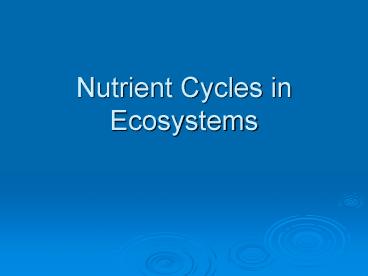Nutrient Cycles in Ecosystems - PowerPoint PPT Presentation
1 / 25
Title:
Nutrient Cycles in Ecosystems
Description:
Arial Wingdings Calibri Helvetica Ripple 1_Ripple Nutrient Cycles in Ecosystems Biogeochemical Cycle PowerPoint Presentation Three Categories Hydrologic Cycle ... – PowerPoint PPT presentation
Number of Views:235
Avg rating:3.0/5.0
Title: Nutrient Cycles in Ecosystems
1
Nutrient Cycles in Ecosystems
2
Biogeochemical Cycle
- The flow of a nutrient from the environment to
living organisms and back to the environment - Main reservoir for the nutrient is in the
environment
3
geochemical cycle
Main nutrient reservoirs in the environment
fraction of nutrient available to ecosystem
herbivores, carnivores, parasites
primary producers
detritivores, decomposers
Fig. 47-14, p.852
4
Three Categories
- Hydrologic cycle
- Water
- Atmospheric cycles
- Nitrogen and carbon
- Sedimentary cycles
- Phosphorus and sulfur
5
Hydrologic Cycle
Atmosphere
precipitation onto land 111,000
wind-driven water vapor 40,000
evaporation from land plants (evapotranspiration)
71,000
evaporation from ocean 425,000
precipitation into ocean 385,000
surface and groundwater flow 40,000
Land
Ocean
Figure 47-15 Page 853
6
TRANSPIRATION
EVAPORATION
PRECIPITATION
interception by plants
dripping, trickling down along stems
falling through to ground
surface pooling, etc.
overland flow
infiltration of soil
moisture in soil
lateral flow
seepage, percolation
groundwater storage
base flow
DEEP OUTFLOW
STREAM OUTFLOW
Fig. 47-16, p.853
7
Water Use and Scarcity
- Most of Earths water is too salty for human
consumption - Desalinization is expensive and requires large
energy inputs - Irrigation of crops is the main use of freshwater
8
Fig. 47-18, p.855
9
Negative Effects of Irrigation
- Salinization, mineral buildup in soil
- Elevation of the water table and waterlogging
- Depletion of aquifers
10
Aquifer Problems
Figure 47-19 Page 855
11
Carbon Cycle
- Carbon moves through the atmosphere and food webs
on its way to and from the ocean, sediments, and
rocks - Sediments and rocks are the main reservoir
12
Carbon Cycle - Marine
diffusion between atmosphere and ocean
combustion of fossil fuels
bicarbonate and carbonate in ocean water
aerobic respiration
photosynthesis
marine food webs
death, sedimentation
incorporation into sediments
uplifting
sedimentation
marine sediments
Figure 47-20 Page 856
13
Carbon Cycle - Land
atmosphere
combustion of fossil fuels
volcanic action
aerobic respiration
combustion of wood
photosynthesis
terrestrial rocks
sedimentation
weathering
land food webs
soil water
peat, fossil fuels
death, burial, compaction over geologic time
leaching, runoff
Figure 47-20 Page 856
14
Carbon in the Oceans
- Most carbon in the ocean is dissolved carbonate
and bicarbonate - Ocean currents carry dissolved carbon
15
Carbon in Atmosphere
- Atmospheric carbon is mainly carbon dioxide
- Carbon dioxide is added to atmosphere
- Aerobic respiration, volcanic action, burning
fossil fuels - Removed by photosynthesis
16
Nitrogen Cycle
- Nitrogen is used in amino acids and nucleic acids
- Main reservoir is nitrogen gas in the atmosphere
17
Nitrogen Cycle
gaseous nitrogen (N2) in atmosphere
nitrogen fixation by industry
food webs on land
uptake by autotrophs
excretion, death, decomposition
uptake by autotrophs
fertilizers
NO3- in soil
nitrogenous wastes, remains
nitrogen fixation
dentrification
ammonification
2. Nitrification
NH3-,NH4 in soil
NO2- in soil
1. Nitrification
leaching
leaching
Figure 47-25 Page 860
18
Nitrogen Fixation
- Plants cannot use nitrogen gas
- Nitrogen-fixing bacteria convert nitrogen gas
into ammonia (NH3) - Ammonia and ammonium can be taken up by plants
19
Ammonification Nitrification
- Bacteria and fungi carry out ammonification
- conversion of nitrogenous wastes to ammonia
- Nitrifying bacteria convert ammonium to nitrites
and nitrates
20
Nitrogen Loss
- Nitrogen is often a limiting factor in ecosystems
- Nitrogen is lost from soils via leaching and
runoff - Denitrifying bacteria convert nitrates and
nitrites to nitrogen gas
21
Human Effects
- Humans increase rate of nitrogen loss by clearing
forests and grasslands - Humans increase nitrogen in water and air by
using fertilizers and by burning fossil fuels - Too much or too little nitrogen can compromise
plant health
22
fertilizer
mining
guano
excretion
agriculture
uptake by autotrophs
uptake by producers
weathering
leaching, runoff
dissolved in soil water, lakes, rivers
land food webs
dissolved in seawater
marine food webs
death, decomposition
death, decomposition
sedimentation
settling out
weathering
uplifting over geologic time
terrestrial rocks
marine sediments
Phosphorus cycle
Fig. 47-27, p.862
23
Phosphorus Cycle
- Phosphorus is part of phospholipids and all
nucleotides - It is the most prevalent limiting factor in
ecosystems - Main reservoir is Earths crust no gaseous phase
24
Phosphorus Cycle
Figure 47-27, Page 862
25
Human Effects
- In tropical countries, clearing lands for
agriculture may deplete phosphorus-poor soils - In developed countries, phosphorus runoff is
causing eutrophication of waterways































